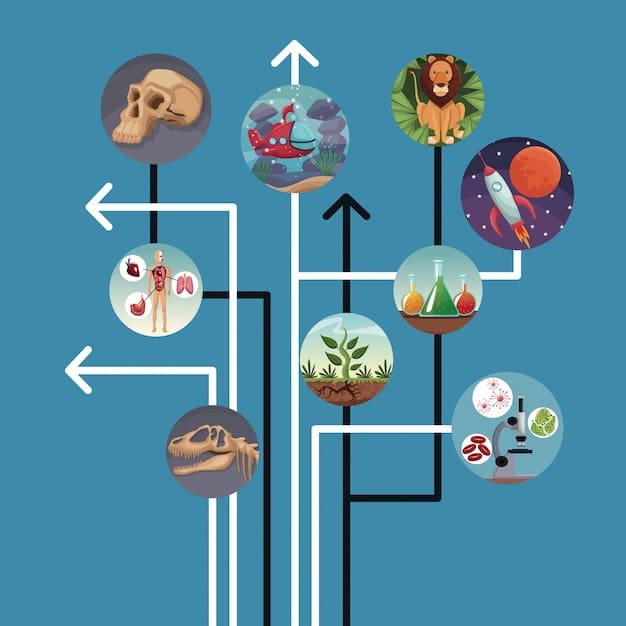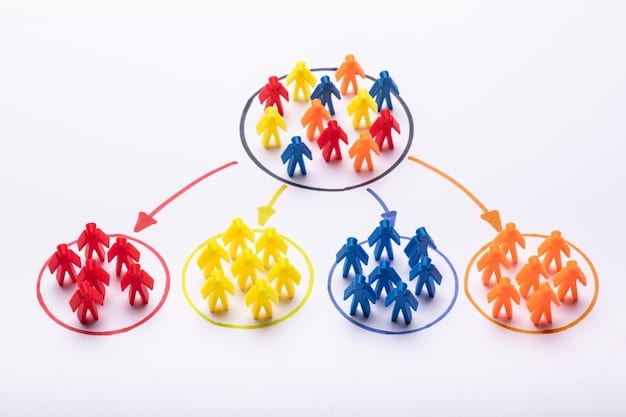Community Resource Needs Assessment: Identifying Priorities Effectively

Community Resource Needs Assessment: Identifying Priorities and Allocating Resources Effectively is crucial for understanding gaps in services and ensuring resources are allocated to meet the most pressing community needs, leading to more impactful and equitable outcomes.
A Community Resource Needs Assessment: Identifying Priorities and Allocating Resources Effectively is a critical process for communities aiming to improve residents’ well-being. This assessment identifies existing resources and gaps, ensuring that funds and efforts are directed where they can have the greatest impact.
Effective community resource allocation starts with a clear understanding of where resources are lacking, and how to address those gaps.
Understanding Community Resource Needs Assessment

A **community resource needs assessment** is a systematic process used to identify the needs of a specific community and the resources available to meet those needs. It involves gathering data, analyzing information, and prioritizing areas where resources are most needed. This process ensures that community initiatives are data-driven and responsive to the actual needs of the population they serve.
Key Components of a Needs Assessment
The success of a needs assessment hinges on several key components:
- Data Collection: Gathering both quantitative and qualitative data through surveys, interviews, and focus groups.
- Stakeholder Engagement: Involving community members, local organizations, and government agencies in the assessment process.
- Data Analysis: Interpreting the collected data to identify patterns, trends, and areas of concern.
Why Conduct a Community Resource Needs Assessment?
Conducting a thorough assessment offers numerous benefits. It helps in:
- Identifying Gaps: Revealing which services are lacking or underutilized in the community.
- Prioritizing Needs: Determining which issues are most pressing and require immediate attention.
- Resource Allocation: Ensuring that funding and programs are directed to the areas where they can have the greatest impact.
By conducting a needs assessment, communities can make informed decisions about resource allocation, leading to more effective and equitable outcomes for all residents.
The community resource needs assessment establishes a foundation for strategic planning, ensuring that resources are used efficiently to address the community’s most critical needs. It involves comprehensive data collection, stakeholder engagement, and rigorous analysis to pinpoint areas requiring attention.
Planning and Preparation for the Assessment
Effective planning and preparation are essential for a successful **community resource needs assessment**. This phase involves defining the scope of the assessment, identifying stakeholders, and developing a detailed plan for data collection and analysis.
Defining the Scope and Objectives
Before starting the assessment, it’s crucial to define the scope and objectives clearly. This includes determining:
- Target Population: Who will be included in the assessment?
- Geographic Area: What specific area will be covered?
- Focus Areas: Which specific issues or sectors will be the focus of the assessment (e.g., healthcare, education, housing)?
Identifying Key Stakeholders
Identifying and engaging key stakeholders is critical. Stakeholders may include:
- Community Members: Residents who will directly benefit from the assessment.
- Local Organizations: Nonprofits, community groups, and service providers.
- Government Agencies: Local, state, and federal agencies responsible for funding and oversight.
Involving stakeholders from the beginning ensures that the assessment reflects the needs and priorities of the community.
Developing a Data Collection Plan
A well-structured data collection plan should outline:
- Data Sources: Which sources of data will be used (e.g., surveys, interviews, existing data).
- Data Collection Methods: How the data will be collected (e.g., online surveys, in-person interviews).
- Timeline: A realistic timeline for completing the data collection process.
Careful planning and preparation lay the groundwork for a comprehensive and effective community assessment.
A well-defined scope, engaged stakeholders, and a robust data collection plan ensure that the **community resource needs assessment** is focused, relevant, and likely to yield actionable insights.

Data Collection Methods
Data collection is a crucial phase in a **community resource needs assessment**, involving the gathering of relevant information to understand the community’s strengths, weaknesses, and unmet needs. Various methods can be employed to collect this data, each with its own advantages and considerations.
Surveys and Questionnaires
Surveys and questionnaires are widely used for collecting quantitative data from a large sample of the population. They can be administered online, by mail, or in person.
Interviews and Focus Groups
Interviews and focus groups are valuable for gathering qualitative data and gaining deeper insights into the community’s perspectives. Interviews can be conducted individually or in small groups.
Analyzing Existing Data
Utilizing existing data sources, such as census data, health records, and local government reports, can provide valuable information about the community’s demographics, health status, and socio-economic conditions.
By employing a combination of these data collection methods, communities can gather a comprehensive understanding of their needs and resources.
Data collection is a multifaceted process that requires careful planning, execution, and analysis. By employing a range of methods and engaging diverse stakeholders, communities can ensure that their needs assessments are comprehensive, accurate, and reflective of the community’s priorities.
Analyzing Assessment Data
Once data has been collected, the next step is to analyze it effectively. Data analysis involves organizing, interpreting, and drawing conclusions from the information gathered.
Organizing and Cleaning Data
Before analysis, data must be organized and cleaned to ensure accuracy and consistency. This may involve:
* Removing duplicate entries
* Correcting errors or inconsistencies
* Coding qualitative data
Identifying Key Findings and Trends
The analysis should focus on identifying key findings and trends that reveal the community’s most pressing needs and gaps in resources.
Data Interpretation
Data interpretation involves translating the findings into actionable insights. This includes:
* Understanding the root causes of identified needs
* Identifying potential solutions
* Prioritizing areas for intervention
Analyzing assessment data enables communities to make informed decisions about resource allocation and program development
Prioritizing Community Needs
Prioritizing **community needs** is a critical step in the assessment process, ensuring that resources are allocated efficiently to address the most pressing issues.
Establishing Criteria for Prioritization
To effectively prioritize needs, it’s essential to establish clear criteria. Common criteria include:
* Severity of the problem
* Impact on the community
* Feasibility of addressing the need
* Availability of resources
Engaging community members and stakeholders in this process ensures that the prioritization criteria reflect the community’s values and priorities.
Developing a Prioritized List of Needs
A prioritized list of needs should be developed based on the established criteria. This list should rank needs from most to least urgent, guiding resource allocation decisions.
Communicating Priorities
Communicating the prioritized list of needs to the community and stakeholders is essential for transparency and accountability. This ensures that everyone understands the rationale behind the prioritization and how resources will be allocated.
By following these steps, communities can effectively prioritize their needs and ensure that resources are used to address the most critical issues.
Prioritizing **community needs** requires a collaborative and transparent process, ensuring that resources are allocated efficiently.
Implementing and Evaluating the Action Plan
After prioritizing community needs, it’s crucial to develop and implement an action plan to address those needs.
Developing an Action Plan
An action plan outlines the specific steps that will be taken to address the prioritized needs. It should include:
* Specific goals and objectives
* Activities and strategies
* Timeline for implementation
* Responsible parties
* Required resources
Implementing the Action Plan
Implementing the action plan requires coordination and collaboration among various stakeholders.
Monitoring Progress and Measuring Outcomes
Monitoring progress and measuring outcomes are essential for evaluating the effectiveness of the action plan. This involves:
* Tracking activities and milestones
* Collecting data on key indicators
* Assessing whether the goals and objectives are being achieved
By implementing and evaluating the action plan, communities can ensure that their efforts are making a positive impact.
| Key Focus | Brief Description |
|---|---|
| 📊 Data Collection | Gathering info through surveys, interviews, and records. |
| 🤝 Stakeholder Engagement | Involving community members in the process. |
| ✅ Action Planning | Creating a plan to apply resources to the community. |
| 🎯 Prioritization | Determining which needs have highest importance. |
Frequently Asked Questions
▼
A community resource needs assessment is a systematic process of identifying the needs of a community and the resources available to meet these needs.
▼
It helps in identifying gaps in services, prioritizing needs, and allocating resources effectively to maximize the impact on the community.
▼
Community members, local organizations, government agencies, and other stakeholders should be involved to ensure a comprehensive and inclusive assessment.
▼
Surveys, interviews, focus groups, and analysis of existing data are common methods used to gather information for the assessment.
▼
A needs assessment should be conducted periodically, ideally every 3-5 years, to ensure that community needs are continuously addressed and resources are utilized effectively.
Conclusion
Effectively conducting a **community resource needs assessment** is crucial for identifying priorities and allocating resources to enhance community well-being. By engaging stakeholders, employing diverse data collection methods, and prioritizing identified needs, communities can create targeted action plans that lead to impactful and sustainable improvements.





